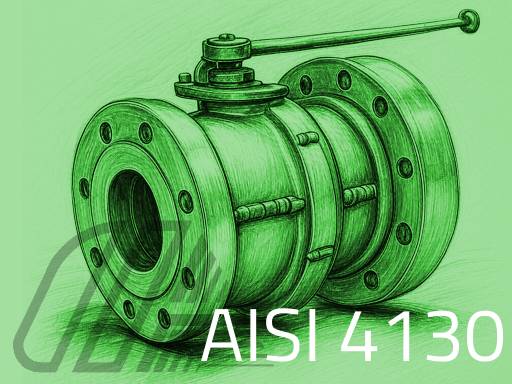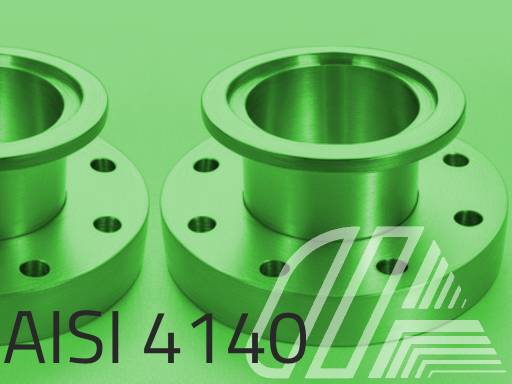Hot work creep-resistant steels (ASTM A182)
HOT WORK CREEP STEELS ARE STEELS THAT HAVE TO RESIST PLASTIC DEFORMATION OVER TIME AT HIGH TEMPERATURES (FROM 350° TO 700°C). THESE STEELS ARE EMPLOYED FOR THE CONSTRUCTION OF VALVES, FLANGES, TIE RODS, TUBES, PLATES ETC. FOR THE CHEMICAL INDUSTRY, PETROCHEMICAL INDUSTRY, THERMAL AND NUCLEAR POWER PLANTS, OVERHEATED STEAM CONVEYORS, ROTORS AND PIPINGS THAT TRANSPORT HOT FLUIDS UNDER PRESSURE. THE SPECIFIC EMPLOYMENTS OF THESE STEELS REQUIRE AN ELEVATED WELDABILITY, FOR THIS REASON THEY ALL HAVE A LOW CARBON CONTENT (MAX. 0,20%).
WE CAN PROVIDE FORGED PARTS WITH SPECIFIC DESIGN UP TO 1000 KG OF WEIGHT WITH MAXIMUM Ø 700 MM.
| steel grades | surface finishing | Ø diameter (mm) |
|---|---|---|
| Aisi 4130 +QT |
hot rolled forged turned |
40-400 |
| Aisi 4140 +QT |
hot rolled forged turned |
32-280 |
| 25CrMo4 |
hot rolled peeled h13/k13 |
30-290 |
| ASTM A350 LF2 |
hot rolled peeled |
20-520 |
| ASTM A105 |
hot rolled peeled |
20-520 |
CORRESPONDENCE TO INTERNATIONAL DESIGNATIONS
| QUALITY | EUROPE | GERMANY | FRANCE | SPAIN | G.B. | USA | |
|---|---|---|---|---|---|---|---|
| EN | DIN | W.n. | AFNOR | UNE | B.S. | AISI/SAE | |
| ASTM A350 - LF2 | S355J2G3~ | St52.3~ | EN50D | LF2 | |||
CHEMICAL ANALYSIS (ASTM A350M-07)
| STEEL DESIGNATION | CHEMICAL COMPOSITION | ||||||||||
|---|---|---|---|---|---|---|---|---|---|---|---|
| SYMBOLIC |
C max |
Mn | Si |
P max |
S max |
Cr max |
Mo max |
Cu max |
Ni max |
V max |
Nb max |
| ASTM A350 - LF2 | 0,30 | 0,60 ÷ 1,35 | 0,15 ÷ 0,30 | 0,035 | 0,040 | 0,30 | 0,12 | 0,40 | 0,40 | 0,08 | 0,02 |
MECHANICAL CHARACTERISTICS (ASTM A350M-07)
| STEEL | ||||||
| SYMBOLIC | NUMERIC | Re min | Rm | A min | Z min | Kv -46°C cl.1 |
| N/mm2 | % | % | J | |||
| ASTM A350 - LF2 | 250 |
485 ÷ 655 |
22 | 30 | 27 | |
USUALLY AVAILABLE EX STOCK
| M.T. COLORATION | QUALITY | HEAT TREATMENT | SURFACE | DIAMETER (mm) |
|---|---|---|---|---|
| ASTM A350 - LF2 | Normalised |
rolled peeled h13 forged turned |
40-300 90-280 300-530 |
|
|
Download technical sheet |
AISI 4130
ASTM A29
Quenced Tempered (+QT)
PROPRERTIES AND APPLICATIONS
AISI 4130, also known as SAE 4130 or 25CrMo4 in the European EN 10250 standard, is a low-alloy, medium-carbon steel celebrated for its excellent strength-to-weight ratio, weldability, and versatility. This chromium-molybdenum alloy steel is a staple in industries requiring components that can withstand high stress while maintaining good toughness and machinability.
AISI 4130 offers high strength while remaining relatively lightweight, making it ideal for applications where weight reduction is critical, such as in aerospace. The presence of chromium and molybdenum allows the steel to be hardened through its cross-section, though its hardenability is lower than that of AISI 4140, making it better suited for smaller sections. AISI 4130 maintains good toughness and ductility, even after heat treatment, ensuring it can withstand impact and dynamic loads.

Common Applications of AISI 4130:
Aerospace Industry: AISI 4130 is widely used in the aerospace sector for components like aircraft structural parts, landing gear, and engine mounts. Its high strength-to-weight ratio and ability to withstand fatigue make it ideal for these critical applications. For example, it is often used in the construction of airframes and roll cages for experimental aircraft.
Oil and Gas Industry: In the oil and gas sector, AISI 4130 is used for components like wellhead equipment, valve bodies, and tubing. Its ability to resist stress corrosion cracking and perform under high-pressure conditions makes it suitable for downhole applications, such as in seamless pipes for drilling operations.
Automotive and Motorsport: AISI 4130 is a favorite in the automotive and motorsport industries for parts like roll cages, suspension components, and chassis frames. Its weldability and strength make it ideal for fabricating lightweight, high-performance structures, such as those used in race cars and off-road vehicles.
Pressure Vessels and Piping: AISI 4130 is often used in the fabrication of pressure vessels, fittings, and piping systems, especially in the energy sector. Its ability to be welded into complex shapes while maintaining strength ensures reliability in high-pressure environments.
General Engineering: The steel is frequently used in general engineering for components like shafts, gears, and fasteners. Its balanced properties make it suitable for applications requiring moderate strength and good fatigue resistance, such as in machinery and industrial equipment.
AISI 4130 is often compared to AISI 4140, which has a higher carbon content (0.38–0.43%), AISI 4130 is more weldable but has lower strength and hardenability, making it better suited for smaller sections or applications where welding is a priority. AISI 4340, with added nickel, offers greater toughness and is better for high-impact applications, but it is more expensive and harder to weld than 4130.
When working with AISI 4130, manufacturers must consider several factors. Its weldability is a significant advantage, but proper preheating and post-weld heat treatment are necessary to avoid issues like cracking, especially in thicker sections. While the steel has some corrosion resistance due to its chromium content, it is not immune to rust and may require coatings or oiling in corrosive environments.
CORRESPONDENCE TO INTERNATIONAL DESIGNATIONS
| QUALITY | EUROPE | GERMANY | FRANCE | SPAIN | G.B. | USA | |
|---|---|---|---|---|---|---|---|
| EN | DIN | W.n. | AFNOR | UNE | B.S. | AISI/SAE | |
| AISI 4130 | ~25CrMo4/~30CrMo4 | 1.7218 | 708A25 | 4130 | |||
CHEMICAL ANALYSIS
| STEEL DESIGNATION | CHEMICAL ANALYSIS | ||||||||
|---|---|---|---|---|---|---|---|---|---|
| SYMBOLIC | C | Mn | Si | P max | S max | Cr | Mo | V | Al max |
| AISI 4130 | 0,28 ÷ 0,33 | 0,40 ÷ 0,60 | 0,15 ÷ 0,35 | 0,035 | 0,040 | 0,60 ÷ 1,10 | 0,15 ÷ 0,25 | - | - |
MECHANICAL CHARACTERISTICS
| STEEL | d ≤ 16mm | 16mm < d ≤ 40mm | 40mm < d ≤ 100mm | 100mm < d ≤ 160mm | |||||||||||||
| SYMBOLIC | NUMERIC | Re min | Rm | A min | KCU min | Re min | Rm | A min | KCU min | Re min | Rm | A min | KCU min | Re min | Rm | A min | KCU min |
| N/mm2 | % | J | N/mm2 | % | J | N/mm2 | % | J | N/mm2 | % | J | ||||||
| AISI 4130 | 1,7218 | 685 | 880 ÷ 1080 |
12 | 32,5 | 635 | 830 ÷ 1030 |
12 | 32,5 | 520 | 740 ÷ 880 |
13 | 30 | 420 | 690 ÷ 830 |
15 | 30 |
JOMINY HARDENABILITY
| STEEL DESIGNATION | RANGE LIMITS | HRC HARDNESS MEASURED FROM THE QUENCHED END OF THE TEST TUBE (MM) | |||||||||||||
|---|---|---|---|---|---|---|---|---|---|---|---|---|---|---|---|
| SYMBOLIC | NUMERIC | 1,5 | 3 | 5 | 7 | 9 | 11 | 13 | 15 | 20 | 25 | 30 | 35 | 40 | |
| AISI 4130 | 1.7218 | max | 56 | 55 | 53 | 51 | 49 | 47 | 45 | 42 | 39 |
37 |
35 | 33 | 32 |
| min | 46 | 45 | 42 | 38 | 35 | 30 | 28 | 26 | 24 | 23 | 21 | 20 | - | ||
USUALLY AVAILABLE EX STOCK
| M.T. COLORATION | QUALITY | HEAT TREATMENT | SURFACE | DIAMETER (mm) |
|---|---|---|---|---|
| AISI 4130 | Quenched and tempered | rolled | 40-400 |
DOWNLOAD
AISI 4140
ASTM A29
Quenced Tempered (+QT)
PROPRIERTIES AND APPLICATIONS

Common Applications of AISI 4140:
Automotive and Aerospace Components: AISI 4140 is widely used in the automotive and aerospace industries for parts like crankshafts, axles, connecting rods, and landing gear components. Its high strength-to-weight ratio and fatigue resistance make it ideal for these high-stress applications.
Oil and Gas Industry: In the oil and gas sector, AISI 4140 is used for drill collars, tool joints, and other downhole components. Its ability to withstand high loads and resist wear in harsh environments, such as drilling operations, ensures reliability and longevity.
Heavy Machinery and Equipment: The steel is a common choice for manufacturing components in heavy machinery, including gears, sprockets, and shafts. Its toughness and wear resistance make it suitable for equipment used in construction, mining, and agriculture.
Fasteners and Bolts: AISI 4140 is often used to produce high-strength bolts, studs, and fasteners for applications requiring exceptional tensile strength, such as in bridges, pressure vessels, and industrial machinery.
Tooling and Dies: While not a traditional tool steel, AISI 4140 is sometimes used for forging dies, die holders, and other tooling components where moderate hardness and high toughness are required. Its ability to be heat-treated to a specific hardness makes it a cost-effective alternative to more expensive tool steels.
General Engineering: AISI 4140 is frequently used in general engineering for structural components like spindles, couplings, and hydraulic system parts, where its balanced properties ensure reliable performance under mechanical stress.
AISI 4140 is often compared to other medium-carbon alloy steels, such as AISI 4340 and AISI 4130. Compared to AISI 4340, which contains nickel for added toughness, AISI 4140 is less expensive and easier to machine but may not offer the same level of impact resistance in extreme conditions
CORRESPONDENCE TO INTERNATIONAL DESIGNATIONS
| QUALITY | EUROPE | GERMANY | FRANCE | SPAIN | G.B. | USA | |
|---|---|---|---|---|---|---|---|
| EN | DIN | W.n. | AFNOR | UNE | B.S. | AISI/SAE | |
| 4140 | ~42CrMo4 | 1.7225 | 708M40 | 4140 | |||
CHEMICAL ANALYSIS %
| STEEL DESIGNATION | CHEMICAL ANALYSIS | |||||||||
|---|---|---|---|---|---|---|---|---|---|---|
| SYMBOLIC | NUMERIC | C | Mn | Si | P max | S max | Cr | Mo | Ni | V |
| AISI 4140 | 1.7225 | 0,38 ÷ 0,43 | 0,75 ÷ 1,00 | 0,15 ÷ 0,35 | 0,035 | 0,040 | 0,80 ÷ 1,10 | 0,15 ÷ 0,25 | - | - |
MECHANICAL CHARACTERISTICS
| STEEL | NORMALISATION TEMPERATURE 900°C MIN – TEMPERING TEMPERATURE 620°C MIN | ||||||
| SYMBOLIC | NUMERICA | Re min | Rm min | A min | Z min | Durezza HB | KV a -46°C min |
| N/mm2 | % | % | max | J | |||
| AISI 4140 | 1,7225 | 520 | 677 | 20 | 45 | 237 | 27 |
USUALLY AVAILABLE EX STOCK
| M.T. COLORATION | QUALITY | HEAT TREATMENT | SURFACE | DIAMETER (mm) |
|---|---|---|---|---|
 |
Aisi 4140 | Quenched and tempered | rolled | 30-300 |
DOWNLOAD
Subcategories
Hot work creep steels (ASTM A182)
HOT WORK CREEP STEELS ARE STEELS THAT HAVE TO RESIST PLASTIC DEFORMATION OVER TIME AT HIGH TEMPERATURES (FROM 350° TO 700°C). THESE STEELS ARE EMPLOYED FOR THE CONSTRUCTION OF VALVES, FLANGES, TIE RODS, TUBES, PLATES ETC. FOR THE CHEMICAL INDUSTRY, PETROCHEMICAL INDUSTRY, THERMAL AND NUCLEAR POWER PLANTS, OVERHEATED STEAM CONVEYORS, ROTORS AND PIPINGS THAT TRANSPORT HOT FLUIDS UNDER PRESSURE. THE SPECIFIC EMPLOYMENTS OF THESE STEELS REQUIRE AN ELEVATED WELDABILITY, FOR THIS REASON THEY ALL HAVE A LOW CARBON CONTENT (MAX. 0,20%).
WE CAN PROVIDE FORGED PARTS WITH SPECIFIC DESIGN UP TO 1000 KG OF WEIGHT WITH MAXIMUM Ø 700 MM.






